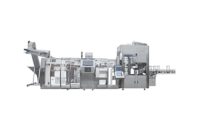Now more than ever is an exciting time to be in the polyurethanes industry, as its technologies and products are part of the global conversation around solving critical challenges. There are endless ways to adapt polyurethane chemistry, but one of the most imperative is its insulation properties. Since 70% of the food we eat in the West is chilled or frozen, polyurethane insulation plays a key role in keeping food fresh throughout the cold chain.
The need for energy efficiency goes across the entire cold chain – from home refrigerators and convenience stores, to the trucks that transport fresh food from farm to market. Each level of the cold chain depends on this unique chemistry to help protect goods during transportation and storage. Polyurethane foam is said to be one of the best insulation technologies available because:
- Superior insulation properties help protect and preserve goods.
- Robust strength due to the rigidity of foam and adhesion characteristics.
- Lightweight to help reduce transportation costs.
- Cost efficiency in manufacturing processes.
- Energy efficiency savings.
We’ve come a long way from chilling our food in a box of ice. Today, polyurethane chemistry protects and insulates, holding up under extreme temperatures. It continues to be the “go-to” product for most appliance manufacturers, helping keep foods fresh and cold while improving energy ratings and cost efficiencies. One element in the insulation process that has come under scrutiny for change is blowing agents.
What are blowing agents?
A blowing agent is a substance capable of producing a cellular structure by a foaming process typically applied when the material is in liquid state. This cellular structure helps reduce density, thus increasing thermal insulation and stiffness of the material. During manufacturing, a blowing agent is used to expand the foam, allowing foam flow into any cavity and providing excellent physical properties. Blowing agents contribute to the superior insulation performance of closed cell polyurethane foam as a result of insulating gas retention in the cells of the foam.
Blowing agents must also satisfy the needs of the application, and need to take multiple requirements into consideration, including cost, flammability, safe and economic manufacturing, load bearing, cushioning and compatibility of materials. Therefore, each foam application has its own specifications, as the density of the foam is determined by the amount of blowing.
From ozone depletant to low GWP
Blowing agents have experienced a vast transformation over the past 30 years. The industry has shifted from ozone depletants like Chlorofluorocarbon and Hydrochlorofluorocarbons, more commonly known as CFCs and HCFCs, to Hydrofluorocarbon, or HFCs. Each regulatory change makes products less harmful to the ozone, but we have the opportunity to preempt future regulations with more sustainable products.
Global warming is driving President Obama’s Climate Action Plan, which has spurred The Environmental Protection Agency’s (EPA) new regulations on high global warming potential (GWP) substances, including foam blowing agents. The final Significant New Alternatives Policy (SNAP) ruling on foam blowing agents bans all high GWP agents by application effective by the end of 2017.
Change isn’t easy, and the EPA’s blowing agent regulation brings a unique set of technical issues to the industry. Scientists from Dow Polyurethanes, a Dow Chemical Co., Midland, Mich., thrive on challenges like this. For years, we have put our innovation engine to work to develop low GWP solutions.
The next-generation of Hydrofluoroolefin (HFO) solutions may lower GWP by 1,000 times compared to previous HFC systems. To meet new blowing agent regulations, companies need to work closely and constantly communicate with polyurethane suppliers. Blowing agent manufacturers should also be involved to ensure end results deliver the performance consumers expect.
During conversion, experts are available to help customers with a smooth and seamless transition and develop chemical formulations that meet their insulation density and energy savings goals.
However, not all blowing agent solutions will work for every application, which is why there are a breadth of capabilities, including:
- HFO: the newest blowing agent technology, designed specifically for low GWP and highest possible performance.
- Pentane: commonly used in roofing insulation, appliances and more, it comes in three primary grades—cyclo-, iso- and n-pentane.
- Water: a rapidly renewable blowing agent that provides an effective option for less demanding insulation applications.
Polyurethane foams naturally reduce global warming potential by reducing the amount of energy needed to power appliances throughout the entire cold chain, including refrigerated trucks and refrigerated cases in grocery and convenience stores. Now, with the next generation low GWP blowing agents, we are reducing the impact of production to increase the net benefit of polyurethane foam insulation for cold chain applications.



